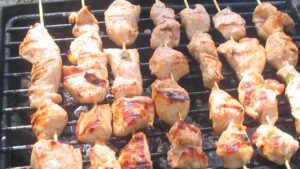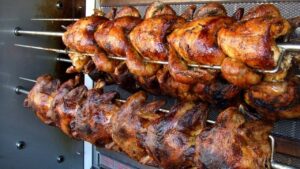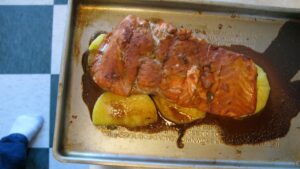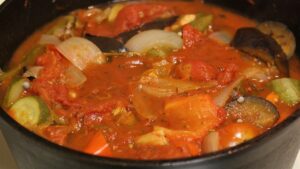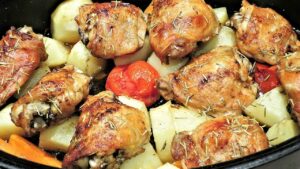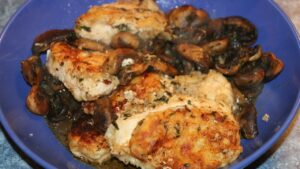What is Grilling?
Grilling is a cooking technique that involves applying dry heat to the surface of food, typically from the top, bottom, or side. It is a popular method used to quickly cook meat and vegetables and typically employs direct, radiant heat.
Grilling is done on an open wire grid or grill that has a heat source either above or below it. Food can be grilled on a cast iron frying pan or a grill pan that has raised ridges resembling the wires of an open grill.
Heat is primarily transferred to the food through thermal radiation when using a grill, whereas a grill pan or griddle relies on direct conduction to transfer heat to the food.
Key Takeaways
- Grilling is a quick, dry-heat cooking technique that employs “significant amounts of direct, radiant heat”.
- Grilling uses thermal radiation, as opposed to frying in a pan or griddle, which uses direct conduction heating.
- Temperature and cooking time are the main distinctions between grilling and barbecue.
- Grilling is quick cooking with high heat, whereas barbecue is slow cooking with low, indirect heat over a long period.
- High heat is used to cook food more quickly and brown meat is more flavourful.
Understanding Grilling

Grilling goes back to the 17th Century in South America and the Caribbean Arawak tribe.
These tribes used sticks to create flames and cook the meat over the fire.
The Barbacoa was the name of the cooking method, later the Spanish people took this method to cook the pigs.
Ellsworth B. A. Zwoyer invented charcoal briquettes in the year 1897.
This design was another company under Henry Ford named Kingsford which formed charcoal with sawdust and wood scraps.
1940 barbeque grills were invented by the people who were living in the suburbs. Grills get filled up in their backyard creating a burning procedure.
This was modified by George Stephen, a welder, as he cut and shaped the metal grills. This is the modern-day grill that is being used to date.
In the year 1960, there was the next revolution by the Arkansas Louisiana Gas Company where William G. Wepfer and Melton Lancaster made a grill that ran on propane which hiked the price.
Advanced grilling came in 1980 by Bill Best with ceramic burners to grill.
Then George Foreman 1990 came up with the invention which saw advancement in 2000 and finally it goes on with progressive ideas to make it much more innovative each time.
According to the scientific explanation, grilling is a quick, dry-heat cooking technique that employs significant amounts of direct, radiant heat.
Grilling uses thermal radiation, as opposed to frying in a pan or griddle, which uses direct conduction heating.
You need to watch what you are cooking carefully because grilling temperatures can frequently exceed 260 °C/500 °F.
Otherwise, your perfectly cooked hot dogs will instantly erupt into road flames.
The browning of proteins and sugars that results in the beautiful coloration and enhanced flavor profile on meat and vegetables is what enhances the flavor of grilled foods.
This browning, known as the Maillard reaction, takes place when foods reach temperatures higher than 155 °C/310 °F.
Temperature and cooking time are the main distinctions between grilling and barbecue.
Grilling is quick cooking with high heat, whereas barbecue is slow cooking with low, indirect heat over a long period.
Importance of Grilling
Great Flavor
Burgers that have been cooked on the grill are the best. The browning of the meat takes place while the food is being grilled and imparts flavor to the beef, fish, chicken, or whatever else is being grilled.
Depending on the grill you use, you can produce different flavors. When using charcoal instead of propane, the flavor is completely different.
A different flavor profile will be added by grilling over wood, giving it a slightly smoky flavor.
Healthier Food
The rendered fat or the oil that the food is being cooked in is where the meat and vegetables sit when cooking in a pan.
One of the main benefits of grilling is that the fat separates from the meat, making it a healthier method of preparation.
Consider grilled chicken tenders or grilled bone-in chicken, where the fat simply drips off to reveal the juicy flavor of the meat.
Due to their accelerated cooking, grilled vegetables will retain more nutritional value.
The beneficial nutrients that are present inside many vegetables are lost when they are boiled or cooked for an extended period.
No Odors Inside
Grilling outdoors keeps the smell of cooking outside if you do not want it inside your home or kitchen.
Grilling outside will get rid of the strong odor that smoked bacon releases when you cook it indoors, whether it is in the winter with the heat on or in the summer.
No Heating Inside
You might prefer to keep the heat from cooking outside during the summer months, which is what grilling does.
An oven keeps the heat in the house for a long time.
That might not be a bad thing in the winter, but in the summer, you want to keep the heat out of the kitchen.
Interacting with Others
Cooking outside on a grill is typically a communal activity. A large crowd will assemble and enjoy themselves around a grill.
Using the chance to cook outside takes us all back to our origins as people; it all began with cooking outside over a fire.
High Heat
You can cook at high temperatures when you grill, which is a fantastic advantage.
This enables you to cook food more quickly and brown meat more flavourful. High heat is the ideal grilling temperature for good meat.
Types of Grills
Direct Heat
Cooking food on a grill directly over the heat source usually entails leaving the lid off. This technique uses high heat to quickly cook food, similar to broiling.
Burgers, a variety of steaks and chops, and most vegetables work best with this technique because they are quick-cooking thin cuts of meat.
Larger cuts of meat should not be cooked this way because high heat will cause them to overcook on the outside before the inside is fully cooked.
Indirect Heat
Use indirect grilling, in which a fire is built on one or both sides of the food and hot air is circulated it, for foods that require longer cooking times (such as whole chickens or pork shoulders, for instance).
Convected heat is produced by a covered grill, which is necessary for indirect grilling.
Compared to direct grilling, it is a gentler cooking technique that enables larger cuts to cook through without over-browning.
Use direct heat if cooking takes less than 20 to 25 minutes; otherwise, use indirect heat.
Tips to Make Grilling Better
Grilling is a fun and delicious way to cook food, and with a few tips and tricks, you can take your grilling game to the next level. Here are some tips to help you make your grilling better:
Preheat your grill: Preheating your grill is essential to ensure that your food cooks evenly. Whether you’re using a gas grill or a charcoal grill, make sure to give it plenty of time to heat up before adding your food.
Clean your grill: A clean grill not only looks better, but it also helps prevent your food from sticking and ensures that your grill is operating at maximum efficiency. Use a wire brush to remove any debris and leftover food from your grill grates before you start cooking.
Oil your food, not your grill: Many people make the mistake of oiling their grill grates before cooking, which can cause flare-ups and uneven cooking. Instead, brush your food with a little bit of oil before placing it on the grill.
Use a meat thermometer: One of the biggest mistakes people make when grilling is overcooking or undercooking their meat. To avoid this, invest in a good meat thermometer and use it to check the internal temperature of your meat.
Let your meat rest: Once you’ve finished grilling your meat, let it rest for a few minutes before slicing it. This allows the juices to redistribute, resulting in a juicier and more flavorful end product.
Experiment with different flavors: Grilling is a great way to infuse your food with different flavors. Try using different wood chips, marinades, and spices to create unique and delicious flavor combinations.
By following these tips, you can make your grilling better and take your outdoor cooking to the next level. So fire up the grill, invite some friends over, and enjoy some delicious grilled food!
Uses of Grilling in Indian Cuisine
One of the most common uses of grilling in Indian cuisine is in the preparation of tandoori dishes. Tandoori cooking involves marinating meat in a mixture of yogurt and spices, which is then cooked in a tandoor oven.
The intense heat of the tandoor oven gives the meat a charred, smoky flavor that is unique to tandoori dishes.
Grilling is also used in the preparation of kebabs, which are a popular snack in India. Kebabs are made by skewering pieces of meat, vegetables, or tofu and grilling them over a charcoal fire. The smoky flavor of the grill adds depth to the flavors of the kebabs.
Another popular use of grilling in Indian cuisine is in the preparation of naan bread. Naan bread is traditionally cooked in a tandoor oven, but it can also be cooked on a grill.
The grill gives the bread a slightly crispy texture and a smoky flavor that is different from the traditional tandoori naan.
Grilling is also used in the preparation of seafood dishes in Indian cuisine. Fish and shrimp are often marinated in a mixture of spices and grilled to perfection.
Grilling brings out the natural flavors of the seafood and gives it a slightly charred taste that is delicious.
Finally, grilling is an important cooking technique in Indian cuisine. It is used in the preparation of tandoori dishes, kebabs, naan bread, and seafood dishes.
Grilling adds a smoky, charred flavor to the food that is unique to Indian cuisine and enhances the rich flavors of the spices used in these dishes.
Conclusion
Grilling is a popular cooking technique that uses direct, radiant heat to quickly cook meat and vegetables.
Its history dates back to South American and Caribbean tribes who used sticks to create flames and cook meat.
Grilling offers various advantages such as great flavor, healthier food, no odors or heating inside, and the opportunity to interact with others.

